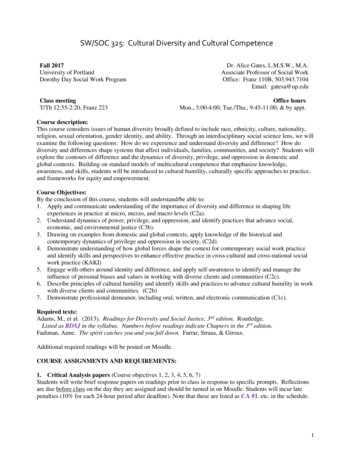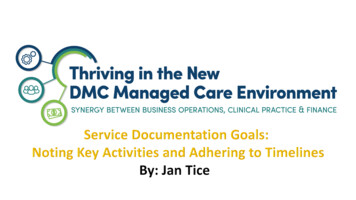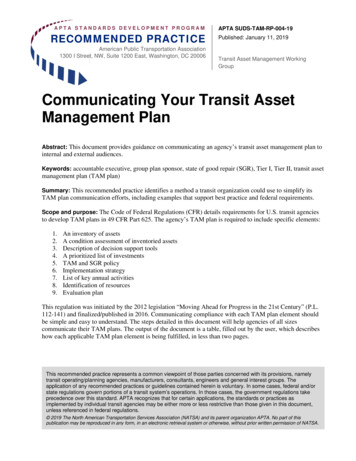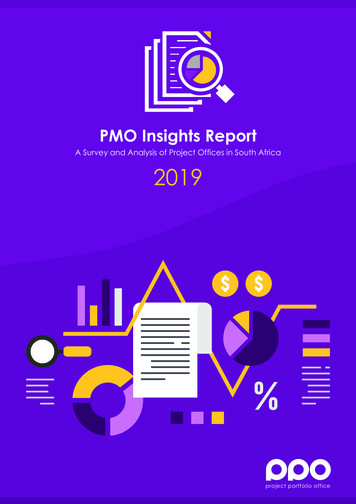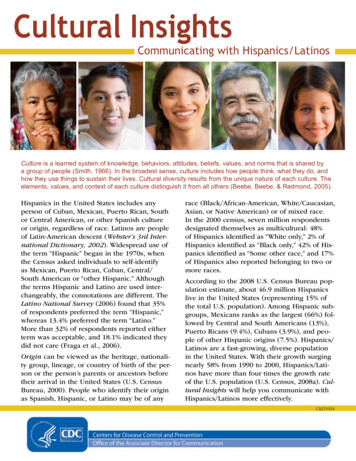
Transcription
Cultural InsightsCommunicating with Hispanics/LatinosCulture is a learned system of knowledge, behaviors, attitudes, beliefs, values, and norms that is shared bya group of people (Smith, 1966). In the broadest sense, culture includes how people think, what they do, andhow they use things to sustain their lives. Cultural diversity results from the unique nature of each culture. Theelements, values, and context of each culture distinguish it from all others (Beebe, Beebe, & Redmond, 2005).Hispanics in the United States includes anyperson of Cuban, Mexican, Puerto Rican, Southor Central American, or other Spanish cultureor origin, regardless of race. Latinos are peopleof Latin-American descent (Webster’s 3rd International Dictionary, 2002). Widespread use ofthe term “Hispanic” began in the 1970s, whenthe Census asked individuals to self-identifyas Mexican, Puerto Rican, Cuban, Central/South American or “other Hispanic.” Althoughthe terms Hispanic and Latino are used interchangeably, the connotations are different. TheLatino National Survey (2006) found that 35%of respondents preferred the term “Hispanic,”whereas 13.4% preferred the term “Latino.”More than 32% of respondents reported eitherterm was acceptable, and 18.1% indicated theydid not care (Fraga et al., 2006).Origin can be viewed as the heritage, nationality group, lineage, or country of birth of the person or the person’s parents or ancestors beforetheir arrival in the United States (U.S. CensusBureau, 2000). People who identify their originas Spanish, Hispanic, or Latino may be of anyrace (Black/African-American, White/Caucasian,Asian, or Native American) or of mixed race.In the 2000 census, seven million respondentsdesignated themselves as multicultural: 48%of Hispanics identified as “White only,” 2% ofHispanics identified as “Black only,” 42% of Hispanics identified as “Some other race,” and 17%of Hispanics also reported belonging to two ormore races.According to the 2008 U.S. Census Bureau population estimate, about 46.9 million Hispanicslive in the United States (representing 15% ofthe total U.S. population). Among Hispanic subgroups, Mexicans ranks as the largest (66%) followed by Central and South Americans (13%),Puerto Ricans (9.4%), Cubans (3.9%), and people of other Hispanic origins (7.5%). Hispanics/Latinos are a fast-growing, diverse populationin the United States. With their growth surgingnearly 58% from 1990 to 2000, Hispanics/Latinos have more than four times the growth rateof the U.S. population (U.S. Census, 2008a). Cultural Insights will help you communicate withHispanics/Latinos more effectively.CS231924
Insights into the Hispanic/Latino Culture1. By 2011, nearly one in six people living in the UnitedStates will be of Hispanic/Latino origin (Selig Center forEconomic Growth, 2006).1. million) of the U.S. teen population and accounted formore than 38% of the total Hispanic population in theUnited States (Cheskin Research, 2006).2. The traditional patriarchal structure grants the father oroldest male relative the greatest authority, whereas womenare expected to show submission (Kemp & Rasbridge,2004).2. Hispanics live longer. Despite having a lower incomethan white Americans, Hispanics live longer than whites.Hispanics have an average life-expectancy of 75.1 yearsfor men and 82.6 years for women compared with whiteAmericans of 74.8 years for men and 80.1 years forwomen (U.S. Census Bureau, 2008a).3. Hispanics come from a collectivistic culture where groupactivities are dominant, responsibility is shared, andaccountability is collective. Because of the emphasis oncollectivity, harmony and cooperation in the group tendto be emphasized more than individual function andresponsibility (Gudykunst, 1998).4. Demographically, Hispanics/Latinos are younger thanthe non-Hispanic population. The median age of theHispanic/Latino population in 2006 was 27.5 yearscompared with that of the U.S. population at 36.9 years.In fact, 62.7% of Hispanics/Latinos are age 34 years oryounger (American Community Survey, 2008).5. Income levels are rising. Although the Hispanic/Latinomedian income is lower than the U.S. average, datasuggest that more Hispanics/Latinos are moving intothe middle class (earning at least 40,000). In addition,Hispanics/Latinos are an increasing proportion of thetotal affluent market (defined as adults with householdincomes of 100,000 or more). From 1991 through 2000,the growth of affluent Hispanics/Latinos rose 126%(U.S. Census, 2008b).6. Hispanic/Latino teens are a growing segment. In 2006,Hispanic/Latino teens made up 20% (estimated 6.33. Getting diseases is a bigger concern than dying. For theHispanic community, issues of morbidity rather thanmortality are of greatest concern, which include lifestyleand behaviors affecting health; environmental factorssuch as exposure to pesticides, unclean air, and pollutedwater; and the ongoing need for more effective use ofexisting health services (National Alliance for HispanicHealth, 2004).4. Household size is larger. The average size of Hispanic/Latino households is 3.47 people compared with 2.62for the total population. In addition, the average familysize of Hispanics (3.92 people) is greater than thatof the total U.S. population (3.22 people) (AmericanCommunity Survey, 2008).5. Children are a big part of family households. In 2008,there were 10.4 million Hispanic family households:62% included children younger than 18 years; 66%consisted of a married couple; 43% included a marriedcouple with children younger than 18 years; and 70% ofHispanic children lived with two married parents (U.S.Census, 2008a).Cultural Insights can help you to communicate more effectively with specific cultures in order toinfluence their behavior. CDC’s Strategic and Proactive Communication Branch (SPCB) in the Officeof the Associate Director for Communication provides CDC programs with culture-specific information such as needs, preferences, and characteristics. SPCB also provides marketing expertise andcommunication planning. To develop Cultural Insights, data is collected and analyzed from books,articles, CDC-licensed consumer databases, and the Internet.For more information, contact Fred Fridinger, SPCB Branch Chief, at FFridinger@cdc.gov.2AUDIENCE: HISPANIC / LATINO POPULATIONSTRATEGIC AND PROACTIVE COMMUNICATION BRANCH
Targeting Health CommunicationKnowing the habits and preferences of Hispanics/Latinos can help you tailor compelling healthmessages for this audience. Consider custom publications becausethese have proven to be an effective way tocommunicate with the Hispanic/Latino market.Companies such as Sears and Procter & Gamblehave invested millions of dollars to reach (andenhance their relationships with) Hispanic/Latino consumers through custom publicationsin Spanish that address their lifestyle interestsand needs (Doublebase Mediamark Research &Intelligence, 2009). Consider using bilingual ad messages to appealto Hispanic/Latino teens—especially fromEnglish-language celebrities “who happen toslip in some Spanish.” Hispanic/Latino teensrespond best to this message type becauseit mirrors their own usage patterns (CheskinResearch, 2006). Use radio and television. Research shows thatalthough Hispanics consume every media type,they seem to have a special attraction to radioand television. These are proven, effectivechannels in targeting Hispanics (Sonderup,2010). Be sensitive to language, which has less todo with competency and more to do withthe cultural meanings people attach to it.For Hispanics/Latinos in the United States,Spanish is a key marker of social, personal, andpolitical identity. As a result, Spanish-languageTV remains important for even those who arefluent English speakers and who regularlywatch English-language TV. In communicatingwith Hispanics, it is not an either/or questionbut a matter of carefully integrating bothlanguages to best communicate with theHispanic/Latino consumer in the United States(Tracy, 2004). Consider starting with the differentiation ofU.S. born and non-U.S. born. By doing that,you will know certain facts about them thatwill help you reach and communicate withthem (Tracy, 2004). Understand that it is important to targethealth messages to men as well as to women.Hispanics typically subscribe to valuesof “machismo” and “marianismo,” whichculturally define the desirable male andfemale qualities. True to these values, men areoften reluctant to consult physicians for healthproblems until someone is so ill that a visitto an emergency room is needed. Fathers orhusbands may make other family members,especially their wives and daughters, wait untilthe last minute to obtain care or may take anuncooperative stance on the health care needsof family members (Parangimalil, 2001). Coordinate community outreach activitiesthrough established and trusted organizationsand people. For example, promotoras aretrusted community health advisors and can beaccessed through Community Health Centers.They visit homes and individually work withfamilies (Maurana & Rodney, 2000). Understand that Hispanics/Latinos areassimilating to prevalent U.S. culture, butthey are not, and probably never will be,fully assimilated. Instead, theirs is a path ofacculturation. It is a process of integratingnative and traditional immigrant culturalvalues with dominant cultural ones (Sonderup,2010).3Send your feedback or questions to SPCBHealthMktg@cdc.govCULTURAL INSIGHTS: HISPANICS/LATINOS
Knowing your AudienceKnow that culture is central in their health habits. Four characteristics have been consistentlyidentified as influencing health habits and should be reflected in communication:1. A reliance on traditional healing systems is common not only because it is culturally approved but also because of thelower costs involved. Expensive modern medical care is unaffordable for many.2. Collectivist values or group orientation permeates Hispanic life, and individuals often look to one another for opinions.A collectivist orientation may serve as a valuable asset for health promotion. For instance, dissemination of informationabout good health habits can be easily achieved in a cost-efficient manner.3. Emphasize cultural diversity within the Hispanic population when conducting health assessments and promotion activities.Subgroups of the Hispanic population such as Mexicans, Puerto Ricans, and Cubans differ in their lifestyles, health beliefs,and health practices.4. Many recent immigrants are less educated than their U.S. counterparts. They may live a marginal life here, on minimalincomes from low-paying jobs, without health insurance or other fringe benefits. The acculturation struggle then becomesa source of stress leading to interpersonal conflicts, family breakdowns, and health problems. Hispanics often accordhealth-related concerns a secondary relevance only, and traditional health- and illness-related habits and behaviors linger(Parangimalil, 2001). Because of their collectivistic values and tendency to look to others to help guide decisions andopinions, consider reaching them through social networks such as Facebook and MySpace, whichfacilitate such collective sharing of information and communication. A recent survey found 44% ofEnglish-preferring Hispanics and 35% of Spanish-preferring Hispanics visit MySpace regularly, whichis greater than any other ethnic group. Facebook was regularly visited by 18% of English-preferringHispanics and 13% of Spanish-preferring Hispanics compared with 7% of non-Hispanic Whites (Korzenny& Vann, 2009). When deciding where to focus health marketing and communication efforts, consider where mostHispanics live. For example, the three primary country groups demonstrate affinities for different regions,creating their own areas of concentration nationwide. Most Mexicans live in the West (55%), 77% ofCubans live in the South, and 59% of Puerto Ricans live in the Northeast (U.S. Census Bureau, 2008a).U.S. Hispanic Population, 2008Top 10 statesCaliforniaTexasFloridaNew YorkArizonaIllinoisNew JerseyColoradoNew 4091,711,4291,533,7671,221,616918,899841,285North Carolina571,307Source: Pew Hispanic Center, 2008.4AUDIENCE: HISPANIC / LATINO POPULATIONSTRATEGIC AND PROACTIVE COMMUNICATION BRANCH
Media HabitsAverage Media UsageMedia typeAveragesMagazines:Issues read in a monthNewspapers:Issues read in a 28-day periodRadio:Half-hours listened to in a weekTelevision:Half-hours viewed in a weekInternet:Times used in a monthTotal 9.9017.2035.8038.5062.6057.1077.6069.30Source: Doublebase Mediamark Research & Intelligence, 2009.Magazines Overall, Hispanics said that the main reason they read magazines is to keep up-to-date on the lateststyles and trends (61%) (Doublebase Mediamark Research & Intelligence, 2009).Top 5 Magazines Read by Hispanics %(last 6 months)PeoplePeople en EspañolNational GeographicTimeSports Illustrated4330292524Source: Doublebase Mediamark Research & Intelligence, 2009.5Send your feedback or questions to SPCBHealthMktg@cdc.govCULTURAL INSIGHTS: HISPANICS/LATINOS
NewspapersThe top reason that Hispanics reported for reading newspapers is because it keeps them informedand up-to-date (55%) (Doublebase Mediamark Research & Intelligence, 2009). Minority newspapers are an inseparable part of the local minority community. These newspapersdeliver what no other mass medium can—news that is specifically geared to the needs and concerns ofindividual minority communities (Sonderup, 2010). Newspaper readership skews to the adult 34–54 year age group with an average annual householdincome of 40,000 or greater (Sonderup, 2010).RadioThe top reason that Hispanics reported for listeningto the radio is because it puts them in a good mood(56%) (Doublebase Mediamark Research & Intelligence, 2009). A unique aspect of Spanish-language radio stationsis the time spent listening. The Hispanic
as Spanish, Hispanic, or Latino may be of any race (Black/African-American, White/Caucasian, Asian, or Native American) or of mixed race. In the 2000 census, seven million respondents designated themselves as multicultural: 48% of Hispanics identified as “White only,” 2% of
